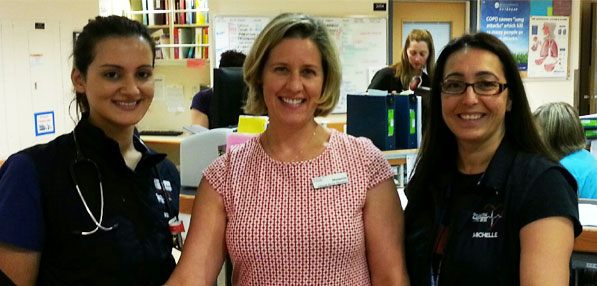Get the inside scoop on 48/6
48/6 is a new model of care being introduced across VCH that will improve the way we do nursing assessments and care plans. The goal is for interdisciplinary teams to work together with patients, and their families, to help them maintain function and independence while in hospital and increase their chances of a safe and timely discharge.
Hear about the pilot at Richmond Hospital
48/6 is currently being piloted on units across VCH. The other week we had the opportunity to talk to Melanie Rydings a clinical nurse educator on 2S at Richmond Hospital where 48/6 is being piloted to find out how it’s being implemented.
Q: When did you first hear about 48/6?
Answer
Q: What was your first impression?
Answer
Melanie: My fist impression was, don’t we do this already in our nursing admissions and patient rounds?
But then as we started to implement the pilot, it became obvious that while we may think and talk about these functional areas of care, we don’t formally document or communicate about them to the broader team.
Q: What was your biggest challenge in implementing 48/6?
Answer
Melanie: With initiatives like this, our biggest challenge is always to transform “work imagined” into “work done”.
Our goal was to create a 48/6 admission assessment that efficiently blended the old documentation with the new. We knew we had to figure out how to fit 48/6 into our existing processes and eliminate areas of duplication.
Q: What was the key to implementing 48/6?
Answer
We used the Plan, Do, Study, Act Model of Improvement and had staff edit and give feedback on the new forms until we had a reasonable working draft that could be taken to the next areas for implementation.
We also provided staff with relief for short periods so they could attend process planning meetings.
Q:What are the benefits of 48/6?
Answer
Melanie: 48/6 has a number of benefits for both staff and patients:
- 48/6 was an opportunity for us to streamline our admission process. Now that we’ve reduced the duplication, we’ve reduced the time it takes to do the initial patient admission assessment from 1.5 hours to less than an hour on average.
- Patients are also much happier that we aren’t asking them the same questions multiple times.
- Our patient rounds are also much more efficient. In the past, if we wanted to know what a patient’s baseline nutrition or mobility function was, we might have to circle back to the family to get the information. Now all the information is at our fingertips in the 48/6 Assessment.
- It’s helped us break down the silos. Now that information about bladder function and mobility is captured together in the assessment, we can work with other members of the rehab team to tackle these issues together.
- The discharge planning section on the forms makes it easy for staff to see what the plan is for patients.
- Lastly, all the care planning and interventions are a permanent part of the chart.
Q: What did you learn about patients that you didn’t know before?
Close
What’s next?
Close
More about 48/6
See sample admission and assessment forms and learn more on the 48/6 page of VCH-Connect.
More about Melanie
Melanie has been a nurse for the last 11 years. She started her career as a medical office assistant but it wasn’t long before she realized she wanted to be directly involved in patient care. She’s been working at Richmond hospital for the last eight years and has been the clinical nurse educator on 2S for six years.

